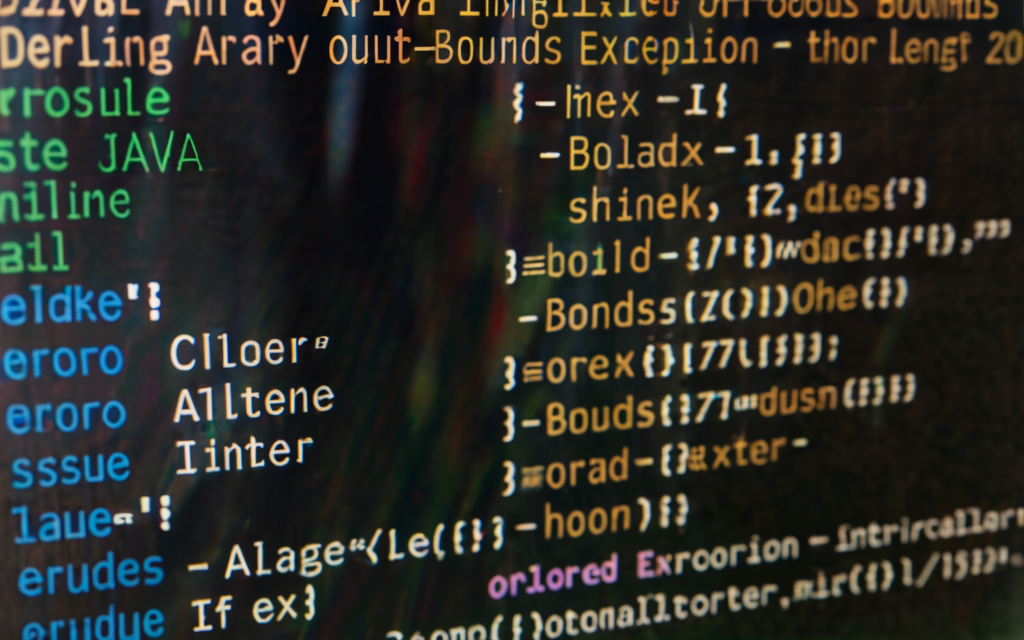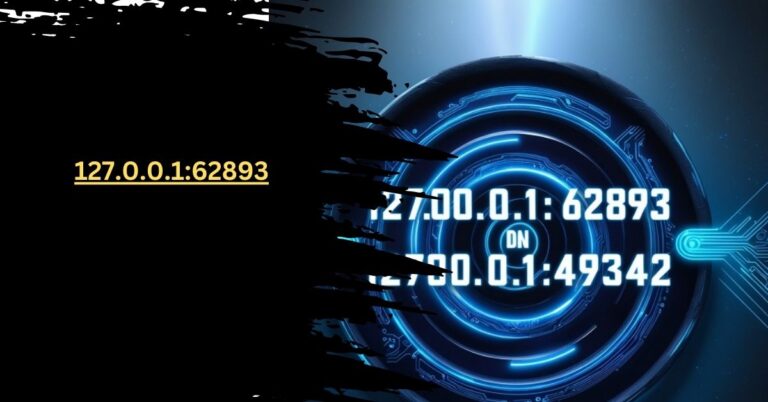java.lang.arrayindexoutofboundsexception: index -1 out of bounds for length 2048
In the realm of Java programming, exceptions are a common occurrence that developers must navigate. Among these, the java.lang.ArrayIndexOutOfBoundsException stands out as a particularly frequent and sometimes perplexing issue. This comprehensive guide delves into the intricacies of this exception, with a specific focus on the error message “index -1 out of bounds for length 2048”. We’ll explore its causes, implications, and most importantly, how to effectively resolve and prevent it in your Java applications.
Introduction to ArrayIndexOutOfBoundsException
The java.lang.ArrayIndexOutOfBoundsException is a runtime exception that occurs when an attempt is made to access an array element with an invalid index. This exception is a subclass of IndexOutOfBoundsException and is thrown to indicate that an array has been accessed with an illegal index. The index is either negative or greater than or equal to the size of the array.
Understanding this exception is crucial for Java developers, as it’s one of the most common errors encountered during array manipulation. The specific error message “index -1 out of bounds for length 2048” provides valuable information about the nature of the exception, which we’ll explore in depth.
Anatomy of the Exception: Breaking Down “index -1 out of bounds for length 2048”
Let’s dissect the error message “java.lang.ArrayIndexOutOfBoundsException: index -1 out of bounds for length 2048” to understand its components:
- java.lang.ArrayIndexOutOfBoundsException: This is the full name of the exception class.
- index -1: This indicates that the code attempted to access an array with an index of -1, which is invalid as array indices in Java start from 0.
- out of bounds for length 2048: This part of the message reveals that the array in question has a length of 2048 elements.
This specific error suggests that the code is trying to access an element at index -1 in an array that has 2048 elements. Since array indices in Java are zero-based and must be non-negative, -1 is an invalid index, resulting in the exception.
Common Causes of ArrayIndexOutOfBoundsException
Several scenarios can lead to an ArrayIndexOutOfBoundsException, particularly with the “index -1 out of bounds for length 2048” error:
- Off-by-one errors: These occur when loop conditions or array access calculations are slightly miscalculated, often by just one.
int[] array = new int[2048];
for (int i = 0; i <= array.length; i++) { // Should be < instead of <=
array[i] = i; // Throws exception when i = 2048
}- Incorrect handling of empty or null collections: When working with collections that might be empty, improper checks can lead to accessing invalid indices.
List<Integer> list = new ArrayList<>();
int lastElement = list.get(list.size() - 1); // Throws exception if list is empty- Misunderstanding array lengths and valid indices: Confusion about the relationship between array length and maximum valid index can cause issues.
int[] array = new int[2048];
int lastElement = array[2048]; // Throws exception, valid indices are 0 to 2047- Incorrect use of array index in algorithms: Some algorithms, particularly those involving searching or sorting, might inadvertently use -1 as an index.
public int binarySearch(int[] array, int target) {
// ... binary search logic
return -1; // Returned when element not found
}
int[] array = new int[2048];
int result = binarySearch(array, 42);
int value = array[result]; // Throws exception if result is -1- String manipulation errors: When working with String methods that return -1 for “not found” scenarios, directly using these return values as array indices can cause problems.
String str = "Hello, World!";
char[] chars = str.toCharArray();
int index = str.indexOf('z'); // Returns -1 if 'z' is not found
char c = chars[index]; // Throws exceptionUnderstanding these common causes is the first step in preventing and effectively handling ArrayIndexOutOfBoundsExceptions in your Java code.
Impact on Application Performance and Stability
The occurrence of ArrayIndexOutOfBoundsException, especially the “index -1 out of bounds for length 2048” variant, can have significant implications for your Java application’s performance and stability:
- Application Crashes: Unhandled exceptions can lead to abrupt termination of your application, resulting in poor user experience and potential data loss.
- Resource Leaks: When exceptions occur in resource-intensive operations, proper cleanup might not occur, leading to memory leaks or other resource issues.
- Performance Degradation: Frequent exception handling, even if caught, can impact your application’s performance due to the overhead of creating and processing exception objects.
- Debugging Overhead: Time spent debugging these exceptions can significantly slow down development and deployment processes.
- Security Risks: In some cases, array index errors can be exploited for buffer overflow attacks, potentially compromising your application’s security.
To mitigate these impacts, it’s crucial to implement robust exception handling and prevention strategies throughout your codebase.
Debugging Techniques for ArrayIndexOutOfBoundsException
When faced with an ArrayIndexOutOfBoundsException, especially the “index -1 out of bounds for length 2048” error, consider these debugging techniques:
- Stack Trace Analysis: Carefully examine the stack trace to identify the exact line of code causing the exception.
- Logging: Implement comprehensive logging to track array operations and index values leading up to the exception.
- Debugger Breakpoints: Set breakpoints around suspicious array operations to inspect variable values at runtime.
- Unit Testing: Develop unit tests that specifically target array boundary conditions to catch potential issues early.
- Code Review: Conduct thorough code reviews focusing on array manipulations and index calculations.
- Static Code Analysis: Utilize tools like SonarQube or FindBugs to automatically detect potential array index issues.
Best Practices for Prevention
To prevent ArrayIndexOutOfBoundsException and similar errors, consider adopting these best practices:
- Bounds Checking: Always validate array indices before accessing array elements.
if (index >= 0 && index < array.length) {
int value = array[index];
} else {
// Handle invalid index
}- Use of Enhanced For-Loops: When possible, use enhanced for-loops to iterate over arrays, eliminating the need for explicit index management.
for (int value : array) {
// Process value
}- Defensive Programming: Implement defensive checks, especially when working with method parameters or return values that might be used as array indices.
public void processArrayElement(int[] array, int index) {
if (array == null || index < 0 || index >= array.length) {
throw new IllegalArgumentException("Invalid array or index");
}
// Process array element
}- Utilize Java Collections: Consider using Java Collections like ArrayList or LinkedList, which provide built-in bounds checking and more flexible operations.
- Consistent Indexing Conventions: Adopt and stick to consistent indexing conventions across your codebase to reduce confusion and errors.
- Code Reviews and Pair Programming: Implement rigorous code review processes and encourage pair programming to catch potential issues early.
- Automated Testing: Develop comprehensive unit tests and integration tests that cover edge cases and boundary conditions for array operations.
Advanced Concepts: Arrays, Indexes, and Memory Management in Java
Understanding the underlying concepts of arrays, indexes, and memory management in Java can provide deeper insights into why exceptions like “index -1 out of bounds for length 2048” occur:
- Array Memory Allocation: In Java, arrays are objects, and their elements are stored in contiguous memory locations. When you create an array, a block of memory is allocated to hold its elements.
- Zero-Based Indexing: Java uses zero-based indexing, meaning the first element of an array is at index 0, and the last element is at index (length – 1).
- Array Bounds: The JVM performs bounds checking on every array access. This is why attempting to access an index outside the array’s bounds results in an ArrayIndexOutOfBoundsException.
- Memory Safety: Java’s strict bounds checking contributes to its memory safety features, preventing buffer overflow vulnerabilities common in languages like C.
- Multidimensional Arrays: In Java, multidimensional arrays are arrays of arrays. Understanding this can help prevent index-related errors in complex data structures.
- Array Covariance: Java allows array covariance, which can sometimes lead to runtime type errors. Understanding this feature can help prevent certain types of ArrayIndexOutOfBoundsExceptions.
Case Studies: Real-world Scenarios and Solutions
Let’s examine some real-world scenarios where the “index -1 out of bounds for length 2048” error might occur and how to resolve them:
Scenario 1: String Processing in a Text Editor
Problem: A text editor application throws an ArrayIndexOutOfBoundsException when trying to highlight syntax for an empty file.
Solution: Implement proper checks for empty or null strings before processing.
public void highlightSyntax(String content) {
if (content == null || content.isEmpty()) {
return; // No highlighting needed for empty content
}
char[] chars = content.toCharArray();
// Proceed with highlighting logic
}Scenario 2: Image Processing Application
Problem: An image processing app crashes with “index -1 out of bounds for length 2048” when attempting to access pixel data of a corrupted image.
Solution: Implement robust error checking and graceful degradation.
public void processImage(BufferedImage image) {
if (image == null || image.getWidth() <= 0 || image.getHeight() <= 0) {
throw new IllegalArgumentException("Invalid or corrupted image");
}
int[] pixels = new int[image.getWidth() * image.getHeight()];
image.getRGB(0, 0, image.getWidth(), image.getHeight(), pixels, 0, image.getWidth());
// Process pixel data
}Scenario 3: Data Analysis Tool
Problem: A data analysis tool encounters ArrayIndexOutOfBoundsException when processing sparse datasets.
Solution: Use more appropriate data structures and implement null checks.
public class SparseDataset {
private Map<Integer, Double> data = new HashMap<>();
public void addDataPoint(int index, double value) {
data.put(index, value);
}
public double getDataPoint(int index) {
return data.getOrDefault(index, 0.0);
}
}Tools and Libraries for Exception Handling in Java
Several tools and libraries can assist in handling and preventing ArrayIndexOutOfBoundsExceptions:
- Apache Commons Lang: Provides utility classes for array manipulation with built-in safety checks.
- Google Guava: Offers immutable collections and precondition checking utilities.
- Project Lombok: Reduces boilerplate code, including for exception handling.
- FindBugs: Static analysis tool that can detect potential array index issues.
- JUnit: Testing framework for creating unit tests to catch array-related errors.
- SLF4J: Logging facade that can help in tracking array operations for debugging.
Future Trends in Java Exception Handling
As Java continues to evolve, we can expect changes in how exceptions like ArrayIndexOutOfBoundsException are handled:
- Pattern Matching: Future Java versions may introduce more sophisticated pattern matching for exception handling.
- Improved Static Analysis: Enhanced compiler warnings and static analysis tools may provide better detection of potential array index issues.
- Functional Approaches: Increased adoption of functional programming paradigms in Java may lead to different approaches to handling collections and arrays.
- AI-Assisted Coding: Integration of AI in IDEs may provide real-time suggestions to prevent common exceptions like ArrayIndexOutOfBoundsException.
- Enhanced Debugging Tools: Future JDK releases may include more advanced debugging tools specifically designed for array and collection-related issues.
Frequently Asked Questions
Q: What causes the “index -1 out of bounds for length 2048” error?
A: This error occurs when trying to access an array element at index -1, which is invalid. It specifically indicates that the array has a length of 2048, but the code is attempting to access an element at a negative index.
Q: How can I prevent ArrayIndexOutOfBoundsException in my Java code?
A: You can prevent this exception by always validating array indices before accessing elements, using bounds checking, and implementing proper error handling in your code.
Q: Is ArrayIndexOutOfBoundsException a checked or unchecked exception?
A: ArrayIndexOutOfBoundsException is an unchecked exception, which means it doesn’t need to be explicitly caught or declared in method signatures.
Q: Can ArrayIndexOutOfBoundsException occur with Java collections like ArrayList?
A: Yes, it can occur with ArrayList when using methods like get() with an invalid index. However, many collection methods have built-in bounds checking.
Q: How does Java’s array bounds checking impact performance?
A: While Java’s array bounds checking provides safety, it can have a slight performance overhead. However, the JVM often optimizes this check, minimizing its impact in most scenarios.
Q: What’s the difference between ArrayIndexOutOfBoundsException and IndexOutOfBoundsException?
A: ArrayIndexOutOfBoundsException is a subclass of IndexOutOfBoundsException. The former is specific to arrays, while the latter is a more general exception used for various index-based operations.
Q: Can ArrayIndexOutOfBoundsException be exploited for security attacks?
A: While ArrayIndexOutOfBoundsException itself isn’t directly exploitable, unhandled exceptions can potentially lead to information disclosure or denial of service if not properly managed.
Q: How should I handle ArrayIndexOutOfBoundsException in production code?
A: In production, you should catch and log these exceptions, provide graceful degradation of functionality, and ensure that the application can continue running without crashing.
Q: Are there any JVM flags or options to help debug ArrayIndexOutOfBoundsException?
A: Yes, you can use JVM flags like -XX:+ShowCodeDetailsInExceptionMessages to get more detailed exception messages, which can be helpful for debugging.






